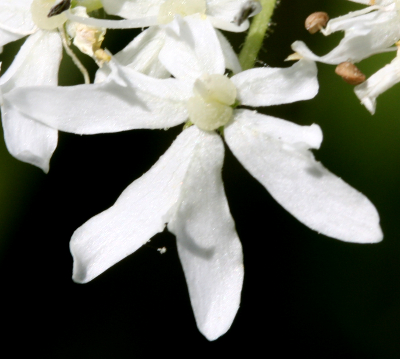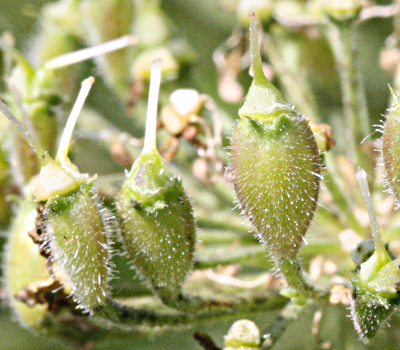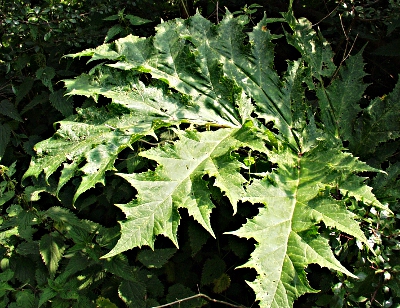Giant hogweed |





Habit, inflorescence, flower, fruits and leaf of the giant hogweed
| Heracleum mantegazzianum Somm. & Lev.: | |
| Blooming period: | June–September |
| Height: | 150–350 cm |
| Flowers: | Ø 5–25 mm, bisexual or male, stamens: 5, styles: 2 |
| Petals: | 5, mostly white, the marginal ones enlarged |
| Calyx teeth: | 5, triangular |
| Stem leaves: | alternate, stalked, simply pinnate, leaflets 2-fold pinnatipartite |
Plant biennial to short-lived, herbaceous, hairy, with thick, yellow, up to 60 cm long, sometimes branched taproot.
Stem erect, strong, hollow, stiff-haired, grooved, round, branched, with reddish or brownish spots, at the base up to 10 cm in cross section. Below the nodes not thickened.
Leaves alternate, petiolate, up to 1.5 m long, usually hairy on the underside, simply imparipinnate with 3–5 mostly double pinnatipartite leaflets. Margins sharply dentate, petioles greatly broadened at the base and sheathing the stem.
Inflorescence: double umbels or umbels of higher order; umbel flat to convex, with 60 to 120 rays, involucre of 10–18 oval to linear, long acuminated leaves.
Raylet leaves (involucel) 10–18, linear. Umbellules with about 35 to 70 flowers.
Flowers of the terminal umbel hermaphrodite, the lateral inflorescences possess often exclusively male flowers.
The marginal petals are
enlarged.
Petals white, rarely reddish, deeply notched at the apex.
The two styles at the fruit time are about 2–3 mm long and slightly spreading.
The inferior ovary, consisting of 2 fused carpels, after self or insect pollination form a 2-part schizocarp.
Fruits 8–15 mm long, yellow-brown, obovate, strongly flattened, winged at margin, with 3 thin ribs on both sides, between them dark brown, club-shaped oil tubes. Plants poisonous!
Heracleum mantegazzianum may hybridize with H. sphondylium but this happens very rarely.
| Floral formula mostly: |
| * K5 C5 A5 G(2) inferior |
Occurrence:
Ditches,
brooks and rivers, roadsides, wastelands, lawns, gardens. Prefers very
sunny, slightly warm, moist and very nitrogenous locations.
Distribution:
Originally
Caucasus, introduced to Europe and North America.